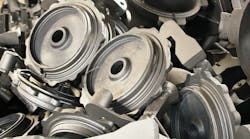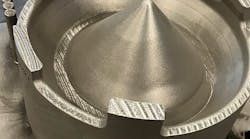Many foundries find it difficult to keep cost down, quality up, stay on schedule, and meet capacity requirements. In many ways these problems come from a lack of dedicated labor and old machine technology — which in effect point to a single problem: outdated core machine technology. The solution is fewer machines and operators, less operator involvement, greater flexibility, consistent productivity, and repeatable quality through innovative reliable technology. Harrison Machine Co. LLC develops advanced cold and hot process coremaking technology that feature dual-station operation, long-life designs, flexibility, productivity, efficiency and high-utilization, and low cost-of- operation.
Dual-station technology runs two different boxes (jobs) at the same time with different blowhole arrangements, different core sizes, different cure cycles, or even different sands. HMC’s dual operating system processes two jobs simultaneously, after the blow, significantly cutting actual machine time and running the shorter cycle internal to the longer one.
Reliability, designed in thanks to 50 years of experience and development, and incorporating today’s safety systems, materials, pneumatic and hydraulic technology, digital control systems, heat transfer and control technology, sensor technology, and 3D CAD system analysis to minimize downtime failures and maximize uptime.
Flexibility also reduces the number of machines needed. The HMC dual-station system easily runs a wide variety of boxes and cycles with custom optimized settings for each core box. It runs both parts of a two-part core at the same time: a long run job on one station, multiple short run jobs on the other; a long cycle with multiple short cycles on one station, heat-up while in production on the other; a gasand- purge one job while investing the other; solid cores on one station and hollow ones on the other; ejection box on one station and manual removal on the other; separate and different optimized gassing and purging temperatures for each box, with an auto unload system fullauto on one or both stations; or changeover or semi-auto operation on one station. The HMC universal quick-change mounting system allows any box to go in any machine it’ll fit on, and so forth.
Productivity and utilization determine how many machines and operators are needed to meet capacity requirements. HMC machines run two jobs simultaneously with one operator, e.g. cores from two boxes in the time it takes to run one, plus six seconds. One operator produces about three times as many cores as with one new singlestation machine, and even more when compared to old machines.
Utilization rates and efficiency increase with changeovers in less than 10 minutes. Heating up of one station takes place while the opposite station is running, using recallable stored settings and machinemonitored processes that eliminate operator interference in the cycle. Cycle times and core quality are repeatable.
Lower operating and ownership cost come from reduced core and casting scrap, reduced waste, reduced labor input, reduced energy usage, and fast payback. HMC reduces core scrap using optimized settings from memory, digital thermal control with +/-5°F variance, high-temperature purge, precision catalyst injection, less waste, thorough curing without post-oven baking, and less resin and catalyst. Dumped shell sand is recycled back to the top hopper. Quick auto scrape-off before curing and lower blow pressures add to the savings. Core-related casting scrap and cost can be reduced with consistent, thorough curing to reduce gas defects by eliminating core shift, from an optimized repeatable coremaking process with consistent finished quality, good shake-out, reduced machining requirements, and reduced melt energy because of less casting scrap.
An operator friendly process is possible with fill-in-the-blank new box settings, point-and-click box program selection from memory, and auto-process monitoring with alarms. The alarm memory provides data for optimization and utilization troubleshooting. When the system is in cycle the operator has only to unload and push ‘cycle start,’ providing him time to inspect, clean, and rack cores. No tools are required for box changes with the quick-change mounting system. No machine adjustments are required from one job to another. All box settings are displayed along with actual process and sensor readings for comparison. Safety systems engage automatically and allow the machine to self-restart after minor alarms.
In all, the number of machines required to meet capacity requirements can be reduced up to 75%, core cost can be reduced over 30%, the number of machine operators can be reduced 75%, capacity can be increased 50%, and productivity can be increased more than 300%, with payback achieved in about one year in most cases.
More information is available from Harrison Machine Co. LLC. Visit www.harrisoncore.com.










